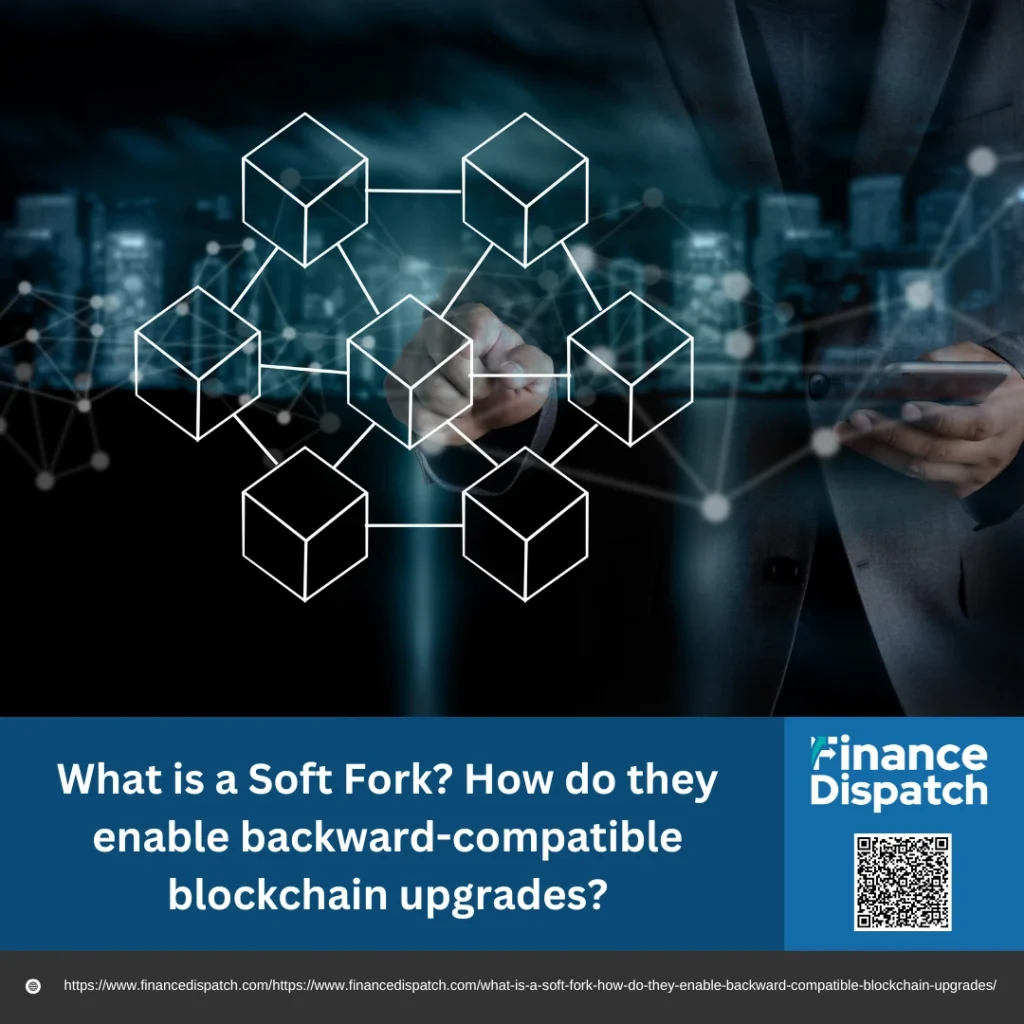Blockchain technology is constantly evolving, and one of the ways it improves over time is through a process known as “forking.” Among the two main types—hard forks and soft forks—the latter plays a crucial role in upgrading blockchain networks without disrupting their existing functionality. A soft fork introduces new rules or features while maintaining compatibility with older versions of the protocol. This means that even nodes that haven’t updated can still participate in the network, ensuring smoother transitions and greater stability. In this article, we’ll explore what a soft fork is, how it works, and how it enables backward-compatible upgrades that keep blockchain systems secure, scalable, and functional for everyone involved.
What is a Soft Fork?
A soft fork is a type of blockchain upgrade that modifies the network’s rules without breaking compatibility with older versions of the software. Unlike a hard fork, which creates a permanent split in the blockchain and often results in the formation of a new cryptocurrency, a soft fork allows upgraded and non-upgraded nodes to continue operating on the same chain. It achieves this by introducing stricter validation rules that still conform to the original protocol, meaning older nodes can still recognize new blocks as valid. This backward compatibility makes soft forks a preferred method for implementing enhancements like security updates or new features while preserving network unity and avoiding disruption.
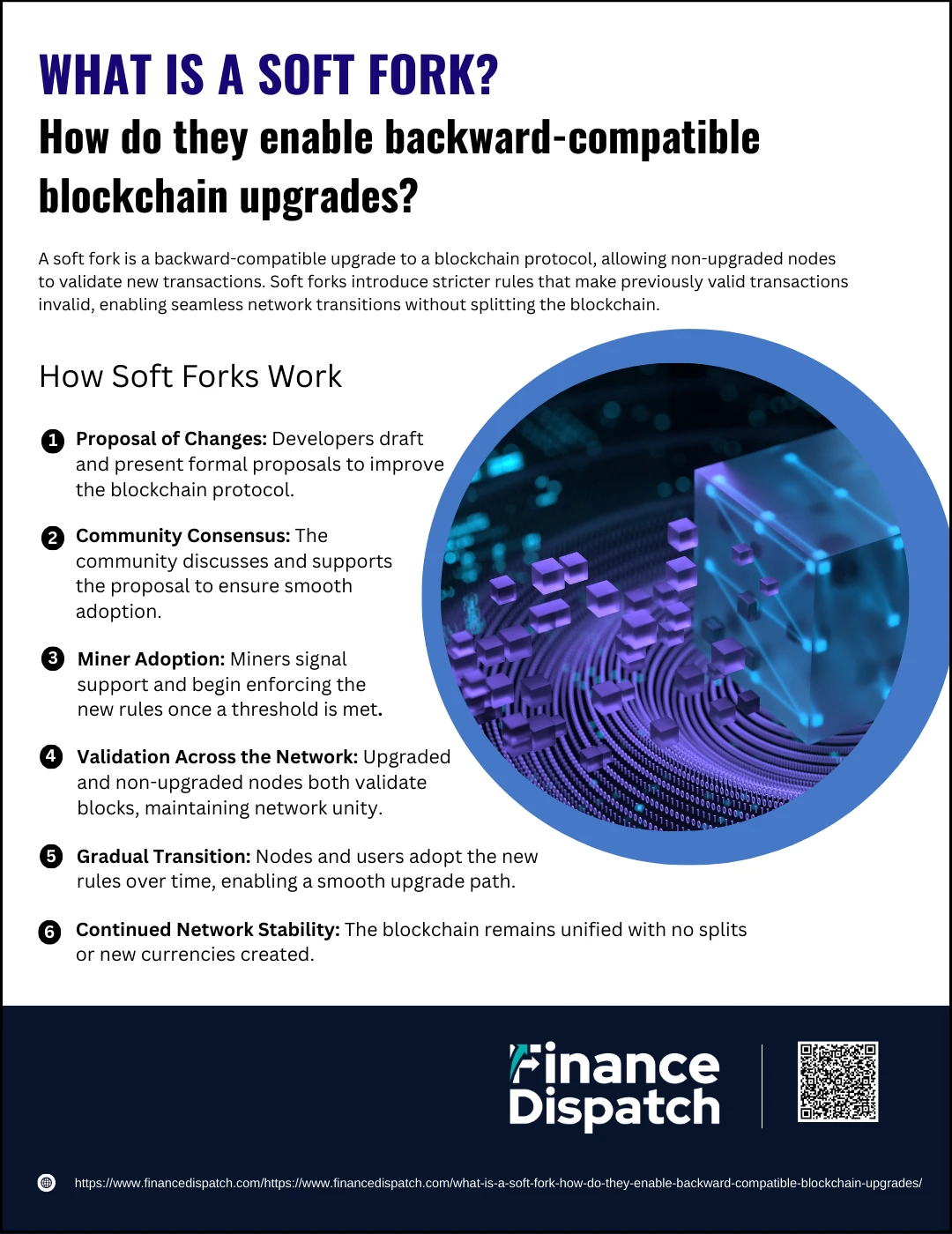 How Soft Forks Work
How Soft Forks Work
Soft forks enable blockchain networks to evolve gradually without disrupting the entire system. They do this by making protocol rules more restrictive—so new blocks still fit within the boundaries of older rules. This means nodes running old software continue to recognize new blocks as valid, even if they can’t utilize the new features introduced. The process emphasizes community coordination and smooth transitions, allowing for improvements without splitting the blockchain. Here’s a more detailed breakdown of each step involved:
1. Proposal of Changes
A soft fork begins with a proposed change to the blockchain’s protocol. This could be a new feature, a bug fix, a security upgrade, or a modification to existing transaction rules. These proposals are usually drafted by developers and presented as formal improvement proposals (e.g., Bitcoin Improvement Proposals or BIPs). The proposal outlines the technical specifications, expected benefits, and compatibility with existing rules.
2. Community Consensus
Once a proposal is introduced, it is shared with the broader community—developers, miners, node operators, and sometimes users—for feedback and discussion. Achieving consensus is crucial to the success of a soft fork. Unlike hard forks, which often require near-universal agreement, soft forks can proceed if a majority of miners support the change. However, widespread community buy-in increases the likelihood of successful adoption and long-term support.
3. Miner Adoption
For the soft fork to be effective, miners need to start enforcing the new rules when creating new blocks. This phase often involves signaling support—miners include specific data in the blocks they mine to indicate they’ve upgraded and are following the new protocol. Once a predefined threshold of miner support is met (often 75% or more), the soft fork can be scheduled for activation at a specific block height.
4. Validation Across the Network
After activation, upgraded nodes begin enforcing the tighter rules defined by the soft fork. Non-upgraded nodes continue to validate blocks as usual, unaware of the changes, but because the new rules are a stricter subset of the old ones, they don’t reject the upgraded blocks. This ensures a smooth coexistence where both types of nodes remain part of the same blockchain.
5. Gradual Transition
One of the biggest strengths of soft forks is that they don’t require everyone to upgrade immediately. Nodes and users can adopt the new software over time, reducing friction and allowing for thorough testing in live conditions. This staggered approach is particularly beneficial in large, decentralized networks, where coordinating a synchronized upgrade would be challenging.
6. Continued Network Stability
Because the blockchain doesn’t split into two separate chains, the network maintains its integrity and continuity. No new cryptocurrency is created, and there’s no confusion over which version is the “real” one. The backward-compatible nature of soft forks ensures that all nodes—old and new—can still contribute to and benefit from the network, supporting long-term scalability and evolution.
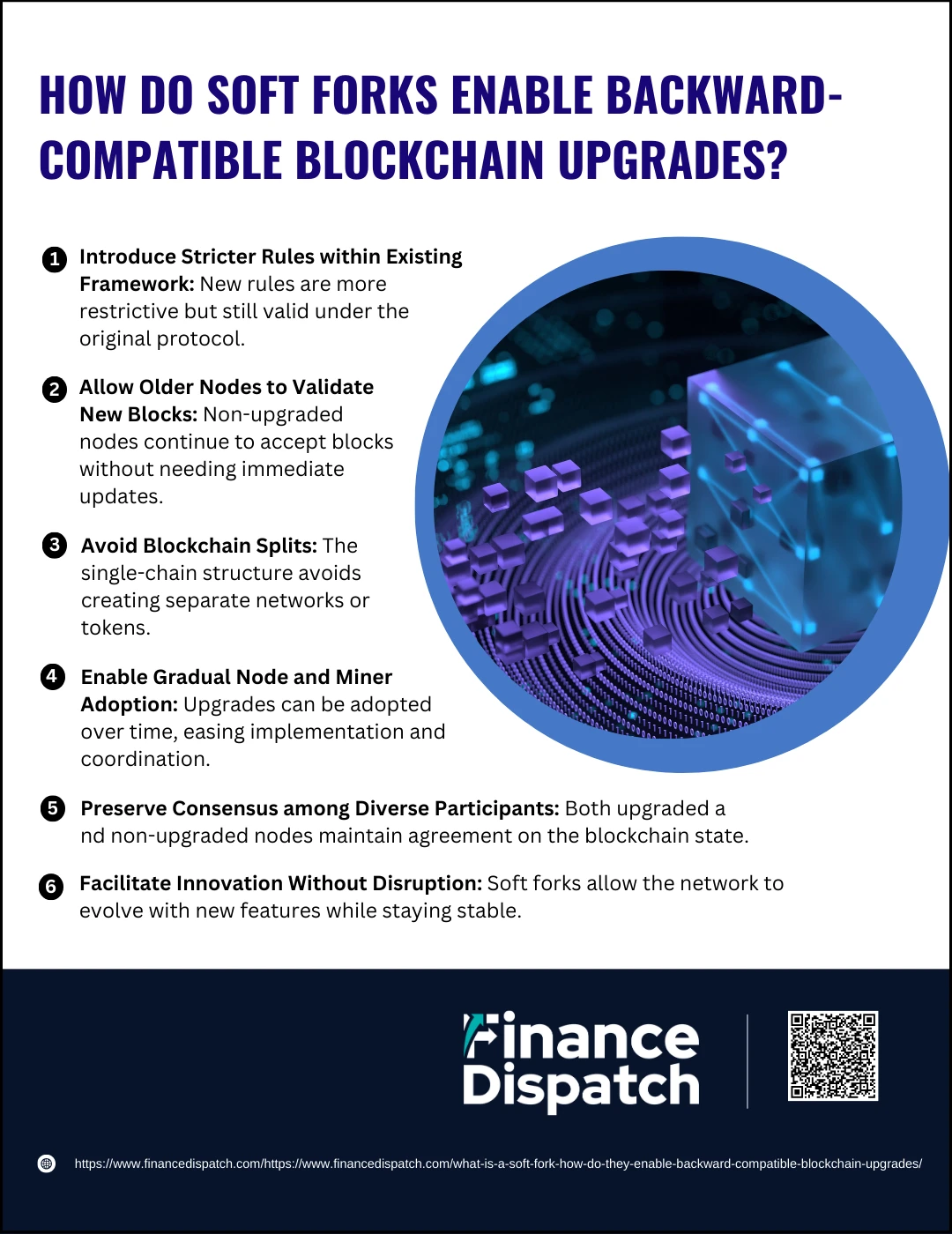 How Do Soft Forks Enable Backward-Compatible Blockchain Upgrades?
How Do Soft Forks Enable Backward-Compatible Blockchain Upgrades?
Soft forks play a vital role in evolving blockchain technology without disrupting existing systems. By tightening the rules rather than overhauling them, soft forks allow newer features to be introduced while still allowing older nodes to participate in the network. This ensures that changes can be implemented smoothly and securely, maintaining consensus and preventing fragmentation. Here’s how soft forks enable backward-compatible blockchain upgrades step by step:
1. Introduce Stricter Rules within Existing Framework
Soft forks don’t rewrite the entire protocol; instead, they add tighter constraints to existing rules. Since these new rules are a subset of the original ones, older nodes still recognize the updated blocks as valid—even if they don’t fully understand the new functionalities.
2. Allow Older Nodes to Validate New Blocks
Because the changes don’t break previous validation criteria, nodes that haven’t upgraded continue to accept new blocks. They can still process transactions, though they may not support the new features—maintaining compatibility without requiring immediate upgrades.
3. Avoid Blockchain Splits
By maintaining a single chain, soft forks prevent the creation of a new cryptocurrency or separate ledger. All transactions stay on the same blockchain, which avoids the confusion, duplication, and risks that come with network splits in hard forks.
4. Enable Gradual Node and Miner Adoption
With backward compatibility, there’s no urgency for all participants to upgrade at once. Nodes and miners can adopt the new protocol at their own pace, which promotes network stability and lowers the barrier to implementation.
5. Preserve Consensus among Diverse Participants
Soft forks help keep the community united by allowing a mix of upgraded and non-upgraded nodes to continue validating transactions. This consensus continuity is key to preserving the integrity and reliability of the blockchain network.
6. Facilitate Innovation Without Disruption
Developers can roll out new features—like improved security mechanisms or more efficient transaction formats—without overhauling the network or fragmenting the user base. This steady evolution helps blockchains stay relevant and resilient over time.
Soft Forks vs. Hard Forks
In the world of blockchain, forks are essential tools for upgrading and improving the network. However, not all forks are created equal. The two main types—soft forks and hard forks—differ significantly in how they handle compatibility, community coordination, and their impact on the blockchain. While soft forks introduce backward-compatible changes that allow both upgraded and older nodes to function together, hard forks make changes that are not compatible with previous versions, often leading to the creation of a new blockchain and cryptocurrency. Understanding the differences between them is key to grasping how blockchains evolve.
| Aspect | Soft Fork | Hard Fork |
| Compatibility | Backward-compatible: old nodes can still validate new blocks | Not backward-compatible: old nodes reject new blocks |
| Network Outcome | Maintains a single blockchain | Creates two separate blockchains |
| Upgrade Requirement | Only a majority of miners or nodes need to upgrade | All nodes must upgrade to stay on the new chain |
| Risk of Network Split | Low | High |
| New Cryptocurrency? | No | Yes (in most cases) |
| Example | SegWit (Bitcoin), Taproot (Bitcoin), Ethereum Merge | Bitcoin Cash, Ethereum Classic |
| Adoption Style | Gradual and voluntary | Immediate and mandatory |
| Used For | Minor updates, feature tweaks, security enhancements | Major protocol changes, disagreements in community direction |
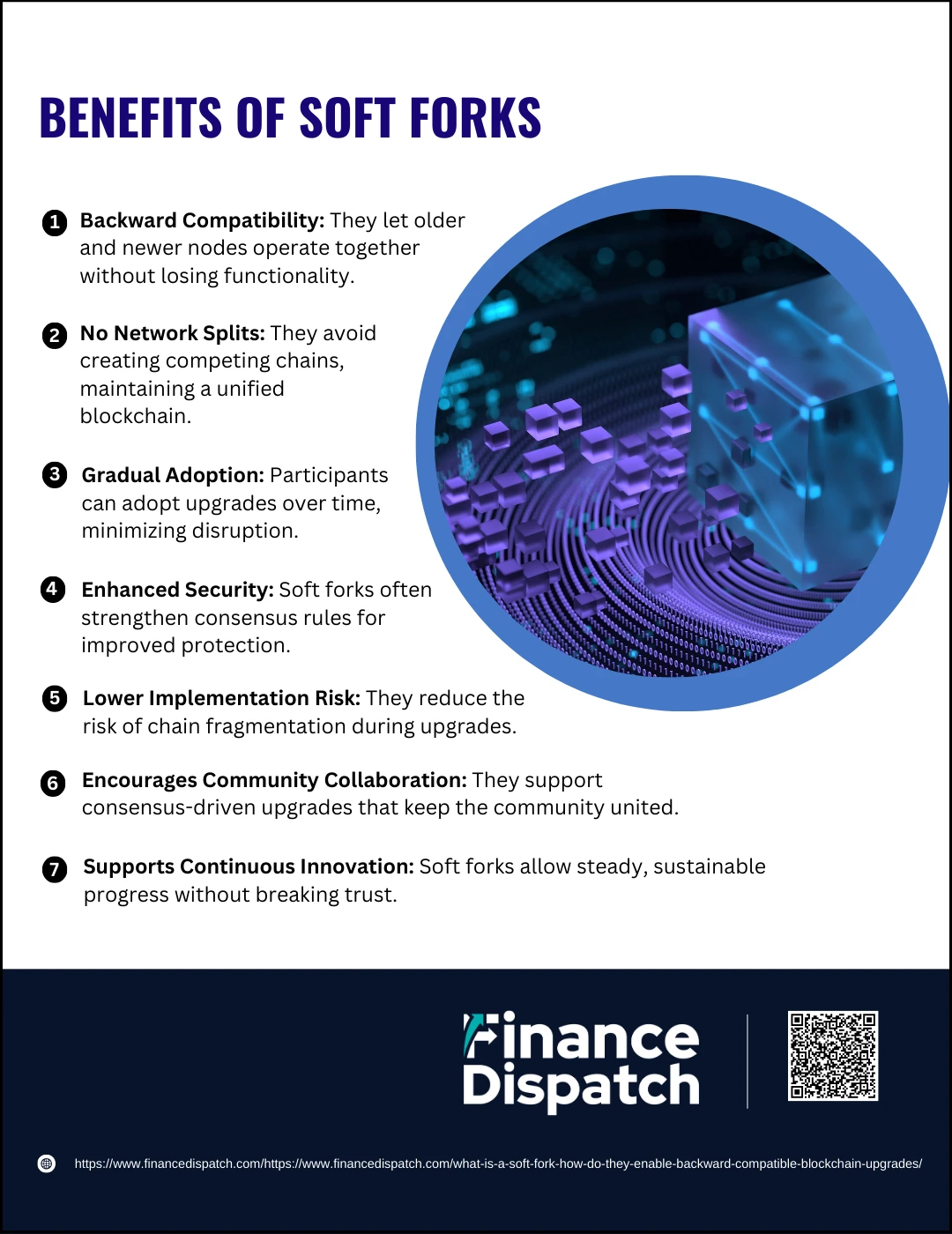 Benefits of Soft Forks
Benefits of Soft Forks
Soft forks provide blockchain developers with a reliable method to introduce upgrades while minimizing risks and maintaining the network’s continuity. Because soft forks are backward-compatible, they let older and newer nodes operate together, preventing disruptive splits and maintaining consensus. This makes them ideal for implementing important improvements—like bug fixes, new features, or tighter security—without forcing every participant to immediately adopt the changes. Their flexible, community-driven approach reflects the core values of decentralization and long-term sustainability in blockchain ecosystems.
Here’s a deeper look at the major benefits of soft forks:
1. Backward Compatibility
Soft forks ensure that new blocks follow rules still recognized by older nodes. This backward compatibility allows non-upgraded participants to remain functional and connected to the network, promoting inclusivity and long-term usability.
2. No Network Splits
Unlike hard forks, which often lead to competing chains and duplicated cryptocurrencies, soft forks maintain a unified blockchain. This helps avoid confusion among users and developers and preserves the value and trust associated with the existing network.
3. Gradual Adoption
Nodes and miners are not forced to upgrade all at once. Instead, they can adopt the new protocol over time, minimizing downtime, reducing the risk of errors, and allowing for more thorough testing in live environments.
4. Enhanced Security
Many soft forks aim to tighten consensus rules or enforce stricter standards, like the introduction of stricter digital signatures or better transaction validation. These enhancements help protect the network against vulnerabilities and malicious attacks.
5. Lower Implementation Risk
Because soft forks don’t create a new chain or require full community synchronization, they carry significantly less risk of network disruption or fragmentation. The existing network continues to operate as normal during and after the upgrade.
6. Encourages Community Collaboration
Soft forks promote cooperative decision-making rather than divisive splits. Achieving majority consensus is usually enough, which helps maintain community unity while still allowing for progress and innovation.
7. Supports Continuous Innovation
Developers can introduce improvements steadily and sustainably. Whether it’s for scaling, privacy, or usability, soft forks allow blockchain projects to evolve at a manageable pace without losing user trust or network reliability.
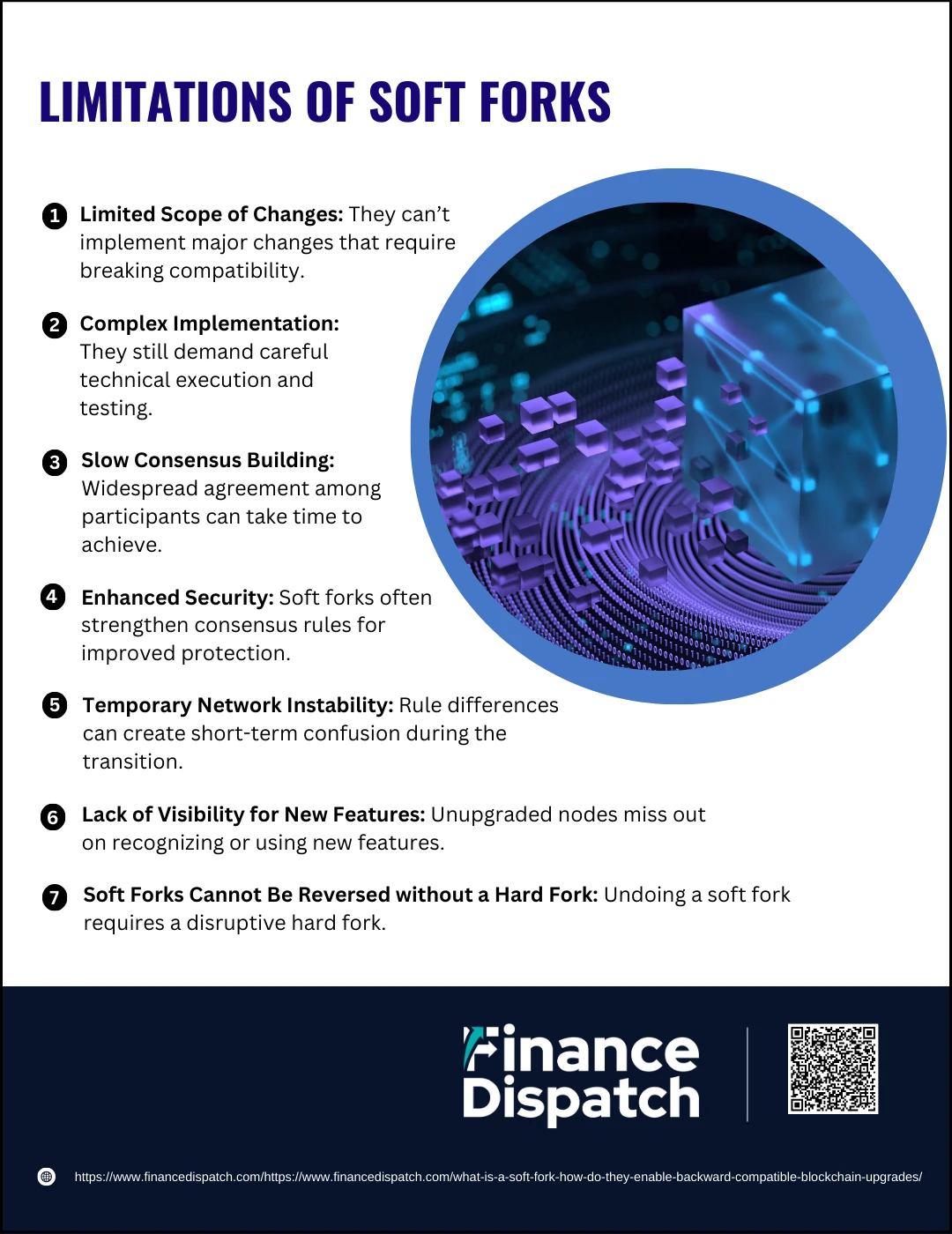 Limitations of Soft Forks
Limitations of Soft Forks
While soft forks offer a practical and less disruptive way to upgrade blockchain networks, they aren’t without their drawbacks. Their backward-compatible nature makes them ideal for certain improvements, but this same feature also limits their scope and flexibility. In some cases, a soft fork might not be sufficient to implement larger changes or resolve deep community disagreements. Understanding these limitations is crucial when considering how and when to use a soft fork in blockchain development.
Here are the key limitations of soft forks:
1. Limited Scope of Changes
Soft forks can only introduce changes that are backward-compatible. This makes them unsuitable for major upgrades that require rewriting or replacing core components of the blockchain protocol.
2. Complex Implementation
Despite being less disruptive than hard forks, soft forks can still be technically complex. They often involve precise changes to consensus rules, which must be carefully tested to avoid bugs or unintended consequences.
3. Slow Consensus Building
Achieving enough support among miners, developers, and nodes for a soft fork can take time. Without broad agreement, the update may fail to activate or gain traction, delaying progress.
4. Potential Miner Exploitation
If some miners choose not to upgrade, they may continue producing blocks under the old rules. This can create inconsistencies or allow exploitation of loopholes that the soft fork aimed to close.
5. Temporary Network Instability
During the transition phase, differences in rule enforcement between upgraded and non-upgraded nodes can cause short-term instability or confusion within the network.
6. Lack of Visibility for New Features
Nodes that don’t upgrade won’t recognize or benefit from the newly added features. While they can still validate blocks, their limited understanding can hinder full network functionality.
7. Soft Forks Cannot Be Reversed without a Hard Fork
Once a soft fork is activated and widely adopted, reversing it requires a hard fork. This can be risky and may defeat the original purpose of avoiding disruption.
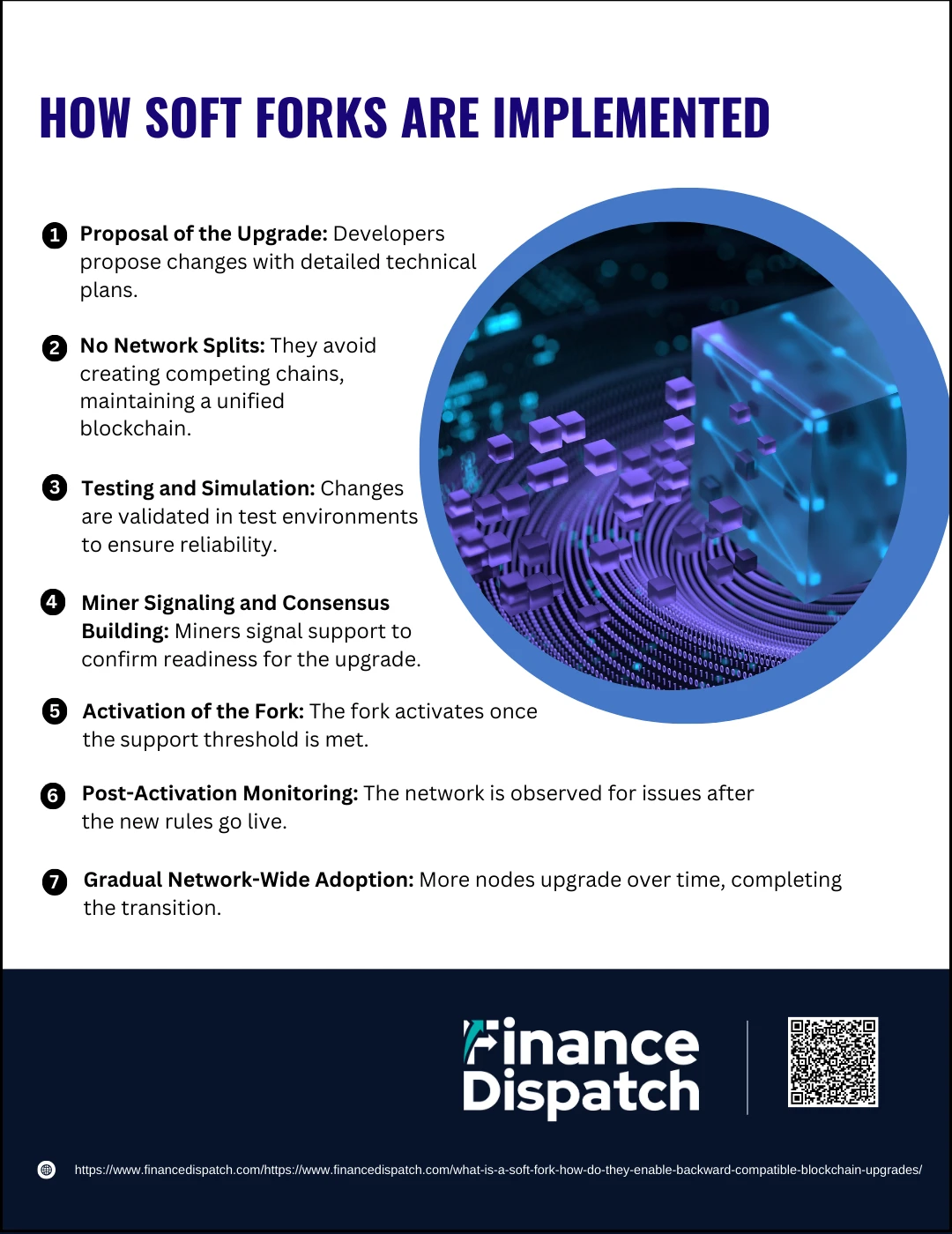 How Soft Forks Are Implemented
How Soft Forks Are Implemented
Implementing a soft fork in a blockchain network is a structured process that requires collaboration, technical precision, and community consensus. Unlike hard forks, which demand universal upgrades and can result in chain splits, soft forks aim to introduce changes while preserving backward compatibility. The implementation process ensures that new rules can be introduced safely without breaking existing systems. Here’s a step-by-step look at how soft forks are typically carried out:
1. Proposal of the Upgrade
The process begins with developers identifying a need for change—this could be for enhanced security, new features, or protocol optimization. They create a formal proposal (e.g., BIP for Bitcoin) detailing the intended modifications and their technical implications.
2. Community Review and Feedback
The proposal is shared with the wider community, including miners, node operators, developers, and users. Open discussions and reviews help refine the proposal and ensure that it aligns with the network’s goals and values.
3. Testing and Simulation
Before implementation, the proposed changes are rigorously tested in controlled environments or testnets. This step is essential to detect bugs, simulate different scenarios, and confirm that the new rules function as intended without breaking the existing network.
4. Miner Signaling and Consensus Building
For the soft fork to activate, a majority of miners (typically around 75% or more) must signal their support. Miners do this by embedding specific markers in the blocks they mine, which indicate their readiness to enforce the new rules.
5. Activation of the Fork
Once the required level of support is achieved, the soft fork is scheduled to activate at a specific block height or time. From that point forward, upgraded nodes begin enforcing the new rules, while non-upgraded nodes still recognize these blocks as valid.
6. Post-Activation Monitoring
After activation, the network is monitored closely to ensure the upgrade performs as expected. Developers and validators watch for issues such as block rejections, reduced mining participation, or irregularities in transaction validation.
7. Gradual Network-Wide Adoption
As confidence grows in the new rules, more nodes and participants gradually upgrade their software. Over time, the entire network transitions to the improved protocol, completing the soft fork without disrupting existing operations.
Types of Soft Forks
Soft forks can be categorized based on how they are initiated and who drives the upgrade process. While all soft forks share the characteristic of backward compatibility, the way they are activated can vary depending on the level of community involvement and the source of consensus. Understanding these types helps clarify how different blockchain communities implement upgrades without splitting the network.
Here are the main types of soft forks:
1. Miner-Activated Soft Fork (MASF)
In a MASF, miners play the leading role in activating the soft fork. They signal support for the new rules by including specific markers in the blocks they mine. Once a defined threshold of miner support (usually a supermajority) is reached, the soft fork is scheduled for activation. This type relies heavily on the cooperation of miners to enforce the upgrade.
2. User-Activated Soft Fork (UASF)
In contrast to MASF, a UASF is driven by full node operators and the wider community of users rather than miners. Participants enforce the new rules by running software that activates the fork at a predetermined time or block height, regardless of miner signaling. UASFs are often used when there is disagreement or slow action among miners, giving power back to the broader community.
3. Emergency Soft Fork
Occasionally, soft forks may be implemented urgently to fix critical bugs or respond to security vulnerabilities. These emergency forks are deployed quickly, often with minimal public debate, to maintain the integrity and security of the blockchain network.
4. Optional Feature Soft Fork
These are soft forks that introduce new features which nodes can choose to use or ignore. While the new rules are enforced at the protocol level, users and applications may opt-in based on their needs, allowing for flexibility in adoption while maintaining consensus.
Real-World Examples of Soft Forks
Soft forks have played a crucial role in the evolution of major blockchain networks like Bitcoin and Ethereum. These backward-compatible upgrades have allowed developers to introduce new functionalities, improve network performance, and strengthen security—without disrupting consensus or splitting the chain. Here are some notable real-world examples of soft forks that have helped shape the modern blockchain landscape:
1. Segregated Witness (SegWit) – Bitcoin (2017)
One of the most famous soft forks in Bitcoin’s history, SegWit separated signature data from transaction data. This improved transaction malleability and increased block capacity without changing the block size limit. SegWit also laid the foundation for scaling solutions like the Lightning Network.
2. Taproot – Bitcoin (2021)
Taproot introduced more efficient and private transaction formats using Schnorr signatures. It enhanced smart contract functionality and reduced on-chain data size, improving scalability and privacy while keeping the network backward-compatible.
3. Pay-to-Script-Hash (P2SH) – Bitcoin (2012)
P2SH allowed users to send funds to a script hash instead of a traditional address, enabling more complex transaction types like multi-signature wallets. This change enhanced Bitcoin’s flexibility and was activated as a soft fork.
4. BIP 66 – Strict DER Signatures (2015)
This soft fork enforced stricter rules for digital signatures by requiring DER encoding. It prevented certain types of attack vectors and improved security across the Bitcoin network.
5. Beacon Chain – Ethereum (2020)
As part of Ethereum’s transition to Proof-of-Stake, the Beacon Chain was launched alongside the existing network. This marked the start of Ethereum’s move to a new consensus mechanism, achieved through multiple soft forks that maintained a single chain.
6. Bellatrix Upgrade – Ethereum (2022)
The Bellatrix upgrade finalized Ethereum’s merge process by transitioning the network fully to Proof-of-Stake. It allowed consensus-layer clients to begin producing blocks, completing Ethereum’s largest upgrade without a hard fork.
Why Crypto Investors Should Care
Understanding soft forks is essential for crypto investors because they directly impact the functionality, security, and long-term value of a blockchain network. A steady stream of well-executed soft forks signals an active and responsive development community—one that’s committed to enhancing the protocol without causing disruptive splits. This reflects stability and forward-thinking governance, which are critical factors for evaluating the health of a cryptocurrency. Additionally, soft forks can introduce features that improve scalability, lower fees, or enhance privacy, all of which can boost user adoption and network value over time. For investors, staying informed about upcoming or recent soft forks helps anticipate market shifts, assess risk, and make more strategic investment decisions.
Conclusion
Soft forks are a foundational element of blockchain evolution, allowing networks to grow, adapt, and improve without causing fragmentation. By enabling backward-compatible upgrades, soft forks preserve the integrity of the existing chain while introducing new features, tightening security, or enhancing performance. This gentle approach to upgrading ensures that all nodes—upgraded or not—can continue to participate in consensus, maintaining network unity. For developers, miners, and investors alike, understanding how soft forks work provides valuable insight into the sustainability and governance of a blockchain. As cryptocurrencies continue to mature, soft forks will remain a vital tool for implementing innovation while keeping the decentralized spirit of blockchain intact.



